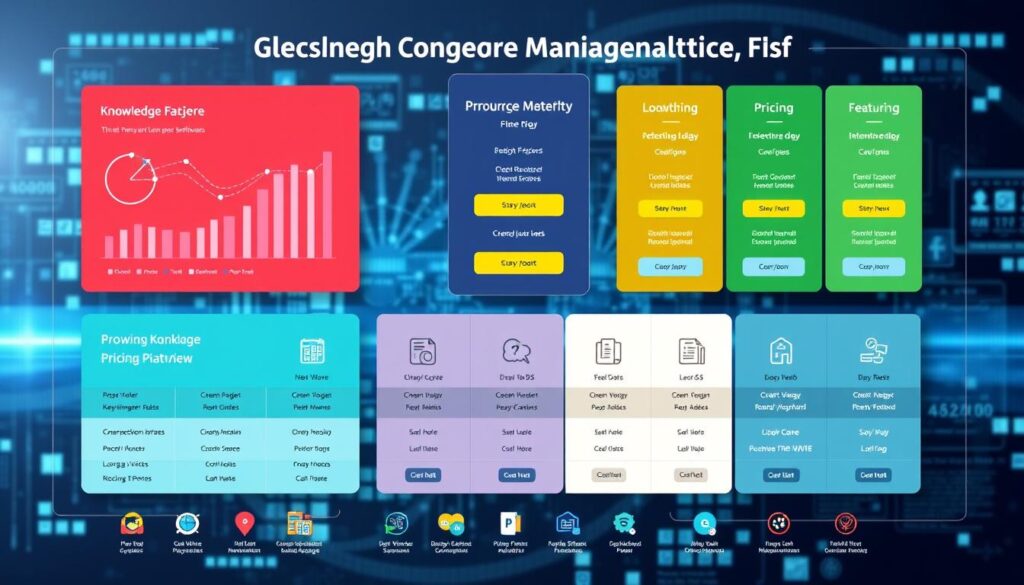FTC disclaimer: This post contains affiliate links and I will be compensated if you make a purchase after clicking on my link.
In today’s fast world, knowing how to manage knowledge is key. Technology can help make sharing and working together easier. This is where knowledge management software comes in – a big help for businesses.
Ever wonder how top companies keep up with their data and team? They use the right tools for knowledge management. These tools help organize content and improve customer service, changing how businesses work.
But, with so many choices, picking the right one can be hard. Don’t worry, we’ve looked into it for you. This guide will cover the 9 best knowledge management software options. We’ll look at their features, strengths, and what might not work for you. Whether you’re small or big, you’ll find the right tool to help your team work better.
Key Takeaways
- Knowledge management software helps businesses organize and share information effectively.
- These tools offer benefits such as improved customer service, faster support solutions, and reduced service volume.
- Top knowledge management solutions include HubSpot Knowledge Base Software, Guru, Document360, KnowledgeBase, and Helpjuice.
- Each platform has its own unique features and capabilities to streamline information sharing and boost team collaboration.
- Choosing the right knowledge management software can significantly impact your organization’s efficiency and productivity.
Introduction to Knowledge Management Software
In today’s world, knowledge management software is key for businesses to succeed. It acts as a central place for all information. This makes sharing and working together easier for everyone.
Systems like Document Management and Enterprise Content Management help a lot. They make work flow better and make the business more productive.
What is Knowledge Management Software?
Knowledge management software helps businesses manage their information well. It keeps all data in one place. This stops information from getting lost and makes it easy for everyone to find and share what they need.
It also helps give better customer service and solve problems faster. This means less work for everyone.
Why it Matters for Businesses
For companies, this software is a big deal. It helps keep important information even when people leave. This makes the whole company work better and make smarter choices.
A McKinsey report says it can make finding information 35% faster. It also makes the whole company 20-25% more productive.
| Key Benefits of Knowledge Management Software | Statistics |
|---|---|
| Improved Efficiency | Fortune 500 companies lose roughly $31.5 billion a year by failing to share knowledge. |
| Enhanced Collaboration | Nuclino rating on Capterra: 4.7/5, Confluence rating on Capterra: 4.4/5, SharePoint rating on Capterra: 4.2/5, Papyrs rating on Capterra: 5/5, GitBook rating on Capterra: 4.5/5. |
| Improved Customer Experience | Global manufacturer MOO reported $52,000 in annual cost savings and a customer satisfaction (CSAT) score of 95% by using Zendesk self-service tools. |
In short, knowledge management software is a great tool. It helps businesses manage information well. This leads to better work, teamwork, and customer service.

Key Features to Look For
When picking the right knowledge management software, look at several key features. These can make your work better, easier, and safer. Knowledge tools and portals are key in today’s work world. Let’s look at the important features to find in your next tool.
User-Friendly Interface
A good user interface is key for easy use and sharing. Choose software that is easy to use and looks good. It should help employees find and add to the knowledge base quickly.
Integration Capabilities
Good knowledge management works with your current tools. Look for software that can connect with your CRM, project management, and more. This makes finding and sharing information easier.
Powerful Search Functionality
Finding the right info fast is important. The best software has advanced search tools. These help users find what they need quickly and easily.
Security and Compliance
As your knowledge grows, keeping it safe is crucial. Choose software with strong security, like access controls and encryption. This keeps your data safe and meets legal rules.
Focus on these features to find software that helps your team. It should make work easier and keep your company’s knowledge safe.
| Knowledge Management Software Features | Benefits |
|---|---|
| User-Friendly Interface | Enhances adoption, boosts productivity, and simplifies knowledge sharing |
| Integration Capabilities | Enables seamless data and workflow synchronization across tools |
| Powerful Search Functionality | Facilitates quick access to relevant information, experts, and resources |
| Security and Compliance | Protects sensitive data and ensures adherence to industry regulations |

“88% of companies have identified Customer Experience (CX) as their top priority, according to Deloitte Digital. Studies show that 91% of customers prefer using a knowledge base to solve their problems.”
With these features, knowledge management software can be a big help. It can improve teamwork, work efficiency, and keep your data safe.
Top Knowledge Management Software Solutions
Businesses have many software options for managing knowledge. These tools help teams store and share important information. Let’s look at some of the best knowledge management software.
1. Confluence by Atlassian
Confluence is a great tool for creating knowledge bases. It works well with other Atlassian products. It’s easy to use and helps teams work together.
2. Notion
Notion is very flexible. It helps with managing knowledge, projects, and notes. It’s good for all kinds of teams, big or small.
3. SharePoint
SharePoint is a Microsoft tool for managing content. It’s great for big companies. It helps with document management and teamwork.
4. Zendesk Guide
Zendesk Guide is for customer service. It makes it easy to keep support documents up to date. It’s good for companies that need to help customers.
Other great tools include KMS Lighthouse, ClickUp, Stack Overflow for Teams, and Slite. Each one meets different needs. The right tool depends on the team and what they need.
| Software | Specialization | Pricing |
|---|---|---|
| Confluence | Wiki-style knowledge base | Starts at $4.89 per user per month |
| Notion | Versatile knowledge management | Starts at $8 per user per month |
| SharePoint | Enterprise content management | Custom pricing based on organization size |
| Zendesk Guide | Customer support knowledge base | Starts at $49 per agent per month |
Exploring these top Knowledge Management Software Solutions helps businesses. They can improve teamwork and make sharing information easier. This leads to better organization and efficiency.
Comparison of Pricing Plans
Knowledge management software prices vary a lot. Some, like Obsidian, are free. Others, like HubSpot’s Knowledge Base Software, cost $360 a month for the pro plan. Prices depend on what you get, how many users, or how much storage you need.
Free vs. Paid Options
For those watching their budget, free software is a good choice. Obsidian is free and has great search and organizing tools. Slite costs $8 a month per user, making it cheap for small groups.
Paid software, however, has more features and support. Helpscout’s Starter plan starts at $20 a month per user. It has better search, teamwork, and integration.
Subscription Models Explained
| Software | Pricing Model | Key Features |
|---|---|---|
| Bloomfire | Undisclosed, with tailored enterprise plans | AI-powered search, multimedia content support, collaboration tools |
| SharePoint | Included in Microsoft 365 plans, starting at $5 per user per month | Robust search, content creation tools, extensive collaboration features |
| Tettra | Starts at $10 per user per month | Keyword search, Slack integration, cost-effective for small teams |
Think about the long-term benefits and how the software will grow with your business. The right plan can make your Best Knowledge Management Software and Knowledge Asset Management work better for you.

User Experience and Accessibility
User experience is key in knowledge management software. The best tools have easy-to-use interfaces and drag-and-drop features. They also let you create custom workflows and dashboards.
This makes it easy for your team to find and use the information they need. It boosts productivity and teamwork.
Mobile Access
In today’s fast world, mobile access is a must. Look for tools that let you access information on any device. This lets your team stay connected and informed, no matter where they are.
It helps them collaborate, share ideas, and make smart decisions from anywhere.
Collaboration Features
- Real-time editing and commenting
- Shared document libraries and version control
- Centralized communication and task management
Knowledge collaboration tools are key for teamwork. Choose a platform that makes communication, file sharing, and project management easy. This helps your team work better together.
Customization Options
Every organization is different. Look for software that lets you customize the interface, workflows, and reports. This flexibility makes sure the tool fits your team’s way of working.
| Feature | Description |
|---|---|
| Mobile Access | Seamless access to knowledge across devices, enabling on-the-go collaboration and decision-making. |
| Collaboration Tools | Real-time editing, shared document libraries, and centralized communication to facilitate teamwork. |
| Customization | Flexible user interface, workflows, and reporting to align with your organization’s unique needs. |

By focusing on user experience and accessibility, you empower your team. They can work more efficiently and effectively. This leads to better business results through knowledge collaboration tools and information sharing platforms.
Best Knowledge Management Software for Small Businesses
As a small business owner, finding the right knowledge management software is key. Look for solutions that are affordable, easy to use, and fit your team’s needs. Notion and Slite are top choices.
Features Tailored for Small Teams
Notion and Slite have flexible pricing and features for small businesses. They focus on easy content creation, basic collaboration tools, and simple user management. This helps your team learn quickly without feeling lost.
- Intuitive interfaces that are simple to navigate
- Seamless integration with popular productivity apps
- Robust search functionalities to quickly find information
- Customizable branding and white-labeling options
Cost-Effectiveness
Small businesses need to watch their budgets. Notion and Slite offer document management system features at good prices. Their flexible plans let you grow without spending too much.
| Software | Pricing | Key Features |
|---|---|---|
| Notion | Starts at $8 per user/month |
|
| Slite | Starts at $6.67 per user/month |
|
Using these knowledge management software solutions, small businesses can empower their teams. They can make workflows smoother and stay ahead in today’s fast market.
Best Knowledge Management Software for Large Enterprises
As companies grow, they need better [Enterprise Content Management](https://document360.com/blog/knowledge-management-software/) tools. These tools must handle a big user base and offer advanced features. They help in making learning systems better and improve teamwork across different departments.
Scalability and Advanced Features
For big companies, [SharePoint](https://document360.com/blog/knowledge-management-software/) and KMS Lighthouse are top choices. They have strong security, can be customized a lot, and work well with other systems. They support thousands of users, give detailed stats, and follow strict rules.
Big companies also need software with cool features. Look for AI suggestions, support for many languages, and great search tools. These help share knowledge worldwide and with different groups.
Compliance and Security Standards
For big companies, keeping data safe is key. Tools like [Confluence by Atlassian](https://document360.com/blog/knowledge-management-software/) and [Zendesk Guide](https://document360.com/blog/knowledge-management-software/) focus on keeping data private. They also follow strict rules to protect important info and ideas.
Choosing the right knowledge management software helps big companies manage content better. It makes learning easier, boosts teamwork, and encourages new ideas through sharing and working together.
How to Implement Knowledge Management Software
Using knowledge management software can change how your team works. It helps you share and use your team’s knowledge better. By planning well, you can make the switch smoothly and get the most out of it.
Step-by-Step Guide
Here are the main steps to use knowledge management software well:
- First, figure out what your team needs to improve. Then, find the software that fits your goals and budget.
- Next, make a detailed plan. This includes when you’ll do things, who will help, and how to make changes.
- Then, move your team’s old knowledge into the new system. This means putting documents and procedures into the software.
- After that, teach your team how to use the software. This is key for them to use it well.
Training and Onboarding Processes
Getting your team to use the software is important. Good training and onboarding can help a lot. Here’s what you should do:
- User guides and tutorials help your team learn the software.
- Interactive training sessions show how to use it in real ways.
- Choose knowledge champions to help and support your team.
By following these steps and focusing on training, you can make your software work great for your team. This will help your team grow and succeed together.
“Knowledge is power. Information is liberating. Education is the premise of progress, in every society, in every family.” – Kofi Annan
Benefits of Using Knowledge Management Software
Using the best knowledge management software can really help your business. It keeps all your team’s knowledge in one place. This makes your team work better together.
Improved Efficiency
Knowledge management software lets your team find what they need fast. This means they spend less time looking for information. They can get back to work faster.
With everything in one place, your team can solve problems quicker. They can make decisions faster too.
Enhanced Collaboration
These knowledge management software tools help your team share knowledge. They work together on projects and share their skills. This breaks down barriers and helps everyone work together better.
It also helps solve problems and come up with new ideas. Everyone learns more together.
Gartner, Inc. says using knowledge asset management software is key. It helps keep important knowledge when people leave. This keeps your business running smoothly and helps your team grow.
Choosing the right best knowledge management software can change your business. It makes your team work better, together, and keeps your knowledge safe.
Challenges in Knowledge Management Implementation
Starting a knowledge management system is tough for companies. It faces many hurdles. One big problem is when employees don’t want to change. They might not like new tools and ways of doing things.
Another issue is when not enough people use the system. If not many people use it, it’s not very helpful. This makes it hard for the system to work well.
Also, bad content management can be a problem. Old systems and messy storage make it hard to keep information up to date. This makes users unhappy and less likely to trust the system.
Strategies for Successful Adoption
To beat these challenges, companies need a smart plan. Here are some steps:
- Explain why the system is good to employees. This helps create a culture where people share and work together.
- Give good training and support. This makes sure users know how to use the system.
- Get leaders to support the system. Their backing helps more people get on board.
- Set clear goals and ways to measure success. This helps see if the system is working.
- Start small with a test run. This lets you get feedback and make changes before using it everywhere.
- Keep the information up to date. This keeps the system useful as the company grows and changes.
By tackling these common problems and using smart strategies, companies can make knowledge management work. This lets them use Knowledge Collaboration Tools and Enterprise Content Management to their fullest.
Conclusion: Choosing the Right Software for Your Needs
Choosing the best knowledge management software is key for your organization. You must think about your needs, size, and budget. The top picks, like Confluence, Notion, and KMS Lighthouse, have different features for various needs.
Recap of Top Options
These leading software solutions have user-friendly interfaces and easy integration. They also have advanced search and strong security. No matter your business size, there’s a perfect match for you.
Final Thoughts on Knowledge Management Solutions
Choosing the right software is just the start. You need a plan for using it well in your organization. This means creating a culture where everyone shares and works together. With the right software, your team can work better, be more productive, and make smarter choices.








